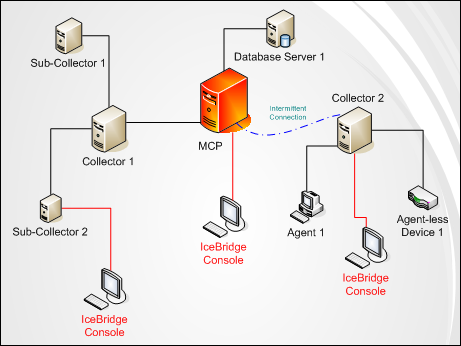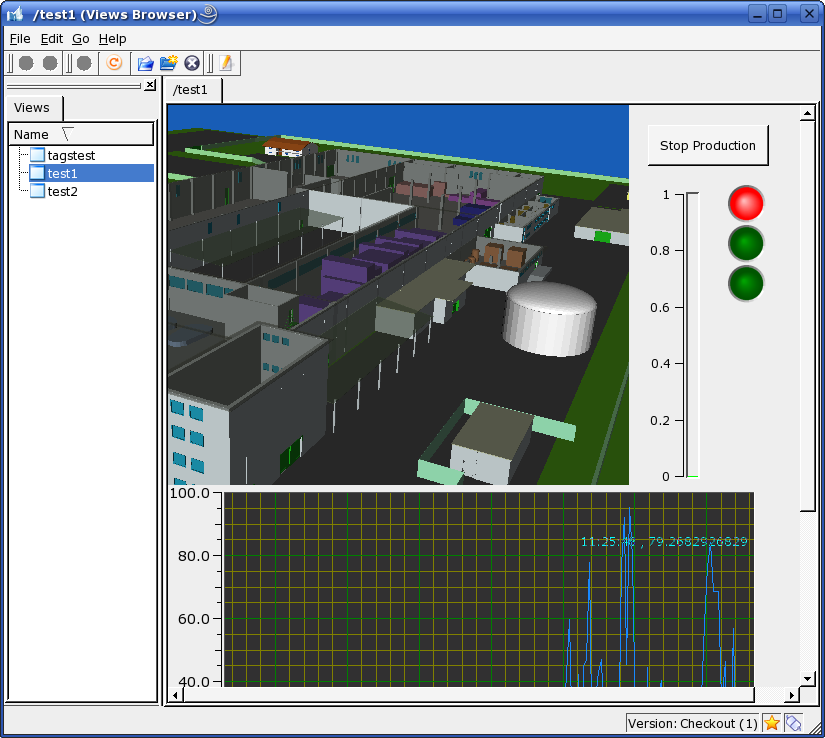The Devil Framework: A Python-based Distributed System For Technology Integration
| Category: | Business |
|---|---|
| Keywords: | cpython, programming, process, integration |
| Title: | The Devil Framework: A Python-based Distributed System For Technology Integration |
| Author: | Alessandro Iob |
| Date: | 2007/03/26 20:21:00 |
| Web Site: | http://www.dlevel.com/ |
| Summary: | D-Level finds Python delivers an order-of-magnitude productivity increase in their development of a platform for distributed technology integration. |
| Logo: | 
|
Introduction
The Devil Framework is a multi-platform (Linux, OS X, Windows), multi-user, multi-tier, distributed platform for developing process and technology integration solutions: developers can easily collect, integrate, correlate, control and visualize all information produced and consumed by heterogeneous networked hardware and software technologies.
The project started in 1999 as a network security data integration system, but when we "discovered" that security is just another process, it evolved to a more general infrastructure for process management.
We are now using it for implementing business/plant integration solutions for business groups (manufacturing, distribution, etc.) with production/business units distributed all over the country.
We are on the way of releasing it as an open-source product with non-commercial and commercial licenses.
Architecture
The Devil Framework system is composed of two different applications: the Application Server components and the IceBridge graphical console. Both are multi-platform applications completely written in Python: the server runs on Linux and Windows platforms (and can be easily ported to other Unix systems), the client runs on Linux, Windows and Mac OS X.
Application Server Components
The Applications Server components are the core of the application development and supervisory control platform for the Devil Framework product line. They provide a unified environment for data collection, data historization, communication, process automation and applications deployment and integration.

Application Server component architecture Zoom in
A component is designed as a plugins-based system. Plugins can be added, removed and updated at run-time, manually or through scheduled policies. Different policies are supported so a component can change functionalities and configurations at scheduled times. Every functionality of a component is implemented via plugins.
Components are designed to work as a tree-like networked structure, with one master node (MCP) where all configuration and plugins installation and updates are performed. All other nodes (Collectors and Agents) automatically get proper configuration and software updates. New nodes can be added at any time to scale data processing, reach new geographic zones or to connect to new devices.

Tree-like distributed system topology Zoom in
Components are designed to work on insecure, unreliable and not-always-connected communication channels. All communication is encrypted (using the pycrypto module) and authenticated through an internal PKI infrastructure (all nodes have their PKI certificates). A store and forward mechanism is used either for the configuration and code propagation systems either for events transmission. Connections can be initiated from any component: parents can call children, and children can call their parent (connections can activated at scheduled times, when specified events occur or when special conditions are detected).
The Application Framework creates a distributed environment where all nodes, from a programming and operative point of view, are seen as an unique system exposing a single API. Operations can be performed on any child node from any parent node, transparently.
IceBridge Graphical Console
The IceBridge console is a multi-platform application written in Python (using the QT/PyQT toolkit/wrapper for the user interface) that provides all tools needed for development, configuration, management and interactive use of the Application Server system.
Like the Application Server's components, the console is a plugins-based system. Plugins are dynamically downloaded from the server when needed or when new versions are available. No user or administrator intervention is needed. Plugins can add, change, augment or hide any console functionality, providing a complete per-user customizable experience.
A complete configuration and visual development environment is integrated into the console (including a version control system for Views and an interactive remote Python shell). Visualization and control forms (called Views) can be added, modified and tested in real-time. New view components (Widgets) can dynamically be made available by plugins.

Real-time system configuration and interface design with "live" widgets Zoom in
Process specific widgets, views, windows and applications can be easily developed and deployed. The system is ready for internationalization; multiple languages are supported and every user can use its preferred language. Moreover, a translation tool (inspired by the QT Linguist Tool) and a WikiWiki-like documentation editing and viewing tool are integrated into the system.

Control view with a custom 3D visualization widget running on Linux and KDE Zoom in
Why Python?
Python was not our first choice as the main programming language it was a coincidence. When we started our project we was very proficient in Perl and completely unaware of Python: so we chose Perl.
We discovered Python when we decided that we had to substitute the PerlTK user interface with a Web-based one. We found Zope, and after some attempts to integrate Perl with Zope, we switched to Python. To make a log story short, at the end we dropped Zope but kept using Python (and rewrote the whole Devil Framework with it).
Without this fortunate switch we think the Devil Framework would not be possible to be developed, at least for a team of only two developers.
Project Statistics
The SLOCCount output says it all:
Totals grouped by language (dominant language first): python: 233020 (97.72%) ansic: 2480 (1.04%) cpp: 1833 (0.77%) makefile: 571 (0.24%) sh: 560 (0.23%) Total Physical Source Lines of Code (SLOC) = 238,464 Development Effort Estimate, Person-Years (Person-Months) = 62.71 (752.50) (Basic COCOMO model, Person-Months = 2.4 * (KSLOC**1.05)) Schedule Estimate, Years (Months) = 2.58 (30.98) (Basic COCOMO model, Months = 2.5 * (person-months**0.38)) Estimated Average Number of Developers (Effort/Schedule) = 24.29 Total Estimated Cost to Develop = $ 8,471,018 (average salary = $56,286/year, overhead = 2.40). SLOCCount, Copyright (C) 2001-2004 David A. Wheeler Please credit this data as "generated using David A. Wheeler's 'SLOCCount'."
On the Persons-Years side, it took us four years for two developers to develop the 2.0 version from scratch (version 1.x was in production use but never released).
Results
As said before, we think that this project would not be possible without the adoption of Python as the main development language, either because of its powerful features either because it was instrumental in the adoption of libraries like PyQT (after having tried to use PerlTK, Web, wxPython), pycrypto and others that let us build a reliable and portable system in a relative small time lapse.
Productivity
Python is our "secret weapon". It gives us order-of-magnitude increases in productivity thanks to:
- Simple syntax and clear coding style: it effortlessly forced us to use a consistent and expressive coding style. Now it's easy to look at a piece of code and understand at a glance how it works (nearly impossible with the first Perl version).
- Rapid development cycle: Python removed the tedious and long code/build/run/crash development cycle.
- It allowed us to development one of the hottest features of our system: when we upgrade or install some new code into the system, it dynamically updates itself, either the client and the server. Imagine this: with a simple double-click you install a plugin on the central server, update it (propagating the changes to all the nodes of the system that are using it), run it, download its client stuff into the console and make it active (dynamically updating the GUI). Everything without restarting nor the server nor the client.
- Extensive and complete standard library and great external modules.
- And when there's no standard library or external module, it's really easy to build wrappers around a third-party library (especially with the ctypes module)
- Easy and fast code refactoring: we have some old code that gets updated all the time.
Cross-platform Development
Porting our application to the different supported platforms was really simple thanks to the great portability of both Python and PyQT and most of the external modules we used in the project. The only real problems we had were caused from platform specific modules (mostly on Window) and from the development of the installation systems (Windows again).
GUI Development
The choice of the PyQT/QT toolkit was fundamental for the development of the client side application. We extensively used other toolkits (Tk and wxPython) before approaching PyQT. No toolkit can compare with its easy of use, power, stability and portability.
As an example, the Mac OS X port of the IceBridge console was possible in less than a week, with most of the time spent in learning how to correctly build the single packages from source and configure the packaging system.

The IceBridge console running under Mac OS X Zoom in
Speed, Scalability and Stability
One of our concerns was the speed of our system. Python proved to be "fast enough" for our uses as the most processor-intensive stuff is already written in C (GUI toolkit, GUID generators, numeric manipulations, etc.). We only had to write, in Python, our custom RPC protocol, because XML-RPC (and it's Python implementation) proved to be too slow and processor-intensive.
Scalability was an issue that we solved at design time, but Python let us create programming constructs like the transparent distributed RPC system and extensible API system.
In regard to stability, we think that Python's great exception handling mechanism gave us an enormous advantage. Our coding errors almost never stop the application and are just about always recoverable.
Real-life Applications
Some sample scenarios where we used the Devil Framework are:
- Management and control of all the technology systems for large-scale retailers from the local stores and the head offices (air-conditioning systems, power consumption control and reduction, data analysis, etc).
- Interface and integration of production systems and accounting systems for manufacturing groups with different production plants and business units located all over Europe (real-time price simulation, live production data analysis and visualization, automated anomaly detection and response, data correlation, etc.).
- Management and control of remote environmental monitoring units (GPS connections, automatic update and reconfiguration of the units, data normalization and analysis, etc.)
Quirks
We had only minor quirks with the Python language itself, only one of which had a real impact on our projects:
- Thread management. We know threads are evil, but sometimes they are invaluable. Not having a way to kill them was something difficult to accept.
- Floating point representation inconsistency between Windows and the rest of the world. We had to perform some nasty tricks to circumvent (partially) this inconsistency.
Conclusion
After so much developing time and so many lines of code we can say without hesitation: "Hail Python, we believe in you!"
It was, and it is still, a pleasure to develop in a such a friendly and powerful language.

